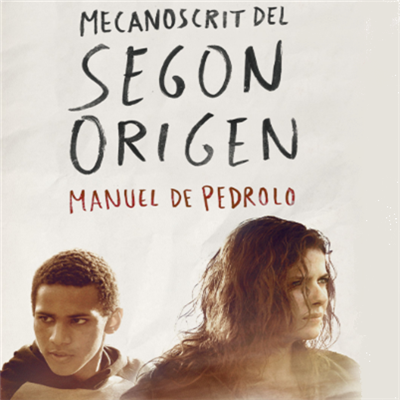Mecanoscrit del segon origen (1974)
Carme Ballús
Between 1973 and 1979 Manuel de Pedrolo wrote what might be called the nucleus of his science-fiction literature about time travel, cracks between two worlds, and contact between humans and alien beings which come to Earth from other parts of the universe in order to take refuge or to destroy it.
The two best known works of this type are the novel Mecanoscrit del segon origen (1974 – Typescript of the Second Origin) and the short story collection Trajecte final (1975 – Final Trajectory). Pedrolo kept working with the genre throughout his literary career. In 1980 he published Aquesta matinada i potser per sempre (Early This Morning and Maybe Forever) which he regarded as his best science-fiction work, and Succés simultani (Simultaneous Event) appeared in 1991.
Typescript of the Second Origin is about the origin of civilisation, described in five chapters of similar length—thirty pages—called “Notebooks”. At the end, there is an Epilogue titled “Is Alba the Mother of Present-Day Humanity?” This section states that the “Notebooks” were discovered more than four thousand years earlier, and details existing theories about their authorship and authenticity. The narrator, pondering an apparent publication of Typescript of the Second Origin, offers information about the history of the text and the various theories about it which have appeared over the four thousand two hundred years since it was written. Since each chapter has a title and the “Notebooks” are also divided into sections, the notes are perfectly ordered when they come down to humanity in the year 6000.
The story in the “Notebooks” is told by an omniscient narrator whose heterodiegetic voice—coming from outside—has total knowledge of what the characters do, feel, and think. Only occasionally is it possible to speak of a film-style, objective, and neutral narrator who looks on and records what is external and visible. In the end, the last six lines of the “Notebook” are written in first person, and it is Alba, the main character, who is speaking.
The question about the origin of humanity starts out from the life of a twentieth-century Catalan girl, Alba. At the age of fourteen, she survives an attack by beings from another planet which wipe out almost all the mammals, including humans, except for those which, for some or other reason, are underwater at the time. Isolated in different parts of the world, the people who survive either go mad or end up killing themselves. Only Alba and her nine-year-old friend Dídac—whom she has just saved by throwing herself into the water—are able to start a new life. They have to overcome many difficulties and their survival depends on their own resources. They must cultivate the land, raise chickens, cure themselves when they are ill, repair machinery, and so on. They learn these skills in books they find in semi-demolished libraries. In order to procreate, they must wait until Dídac is of an age to father a child. Then they have a son, Mar.
As in his early novels where Pedrolo reflects on the repression of women, showing his female characters as victims of a patriarchal society, in Typescript of the Second Origin, Alba is a heroine who, faced with the need for her own survival and that of the human species, struggles to achieve this and to transcend all the taboos and roles traditionally assigned to women.
As for the language the narrator uses, it is clearly literary, of refined expression, with carefully chosen vocabulary, and literary devices like comparisons, metaphor, and enumeration, in addition to set phrases and vernacular expressions giving variety to the narrative tone. However, the dialogue between Alba and Dídac is colloquial, remarkably expressive, and consisting of short sentences with a lot of punctuation marks, although without reproducing the argot of young people of the time when the book was written. It is idiomatic language that remains within the bounds of a certain formality.
Although there is no evidence that Typescript of the Second Origin was conceived as a novel for young people, it is in this segment of the population where the book has been most successful, to the extent of becoming a classic of young people’s literature in Catalonia. Manuel de Pedrolo is convincing in his account of the experience of two adolescents starting out anew, accepting this extraordinary opportunity for living their lives, and being guided by adult experience only to the extent that they glean it from books. They are totally free when it comes to deciding what really interests them and setting their own rules. It is hardly surprising that generations of adolescents have been—and still are—captivated by this novel.
Carme Ballús. About Typescript of the Second Origin, Visat, 4 (October 2007)




